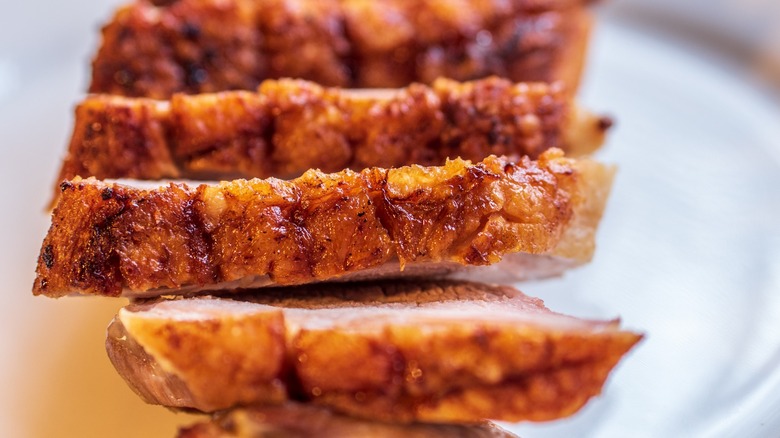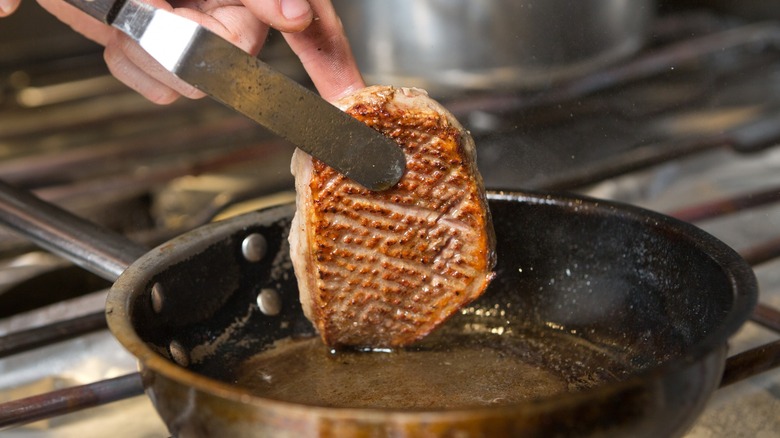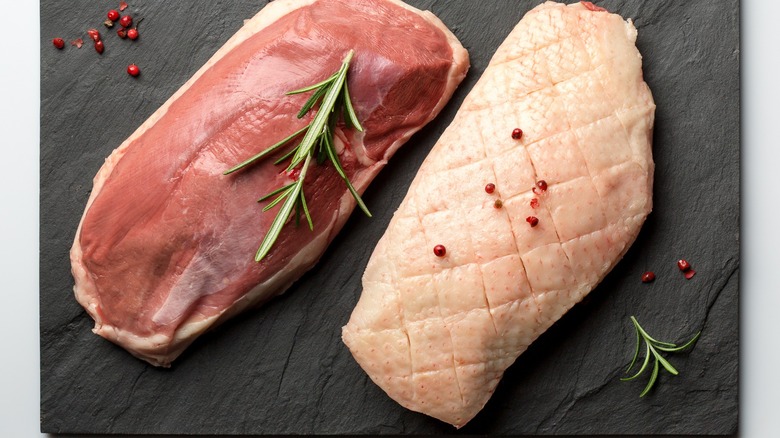The Key To Avoiding Greasy Duck Meat Is Properly Rendering The Fat
Duck is one ingredient that some find challenging, and there's a reason — there are several ways someone can make a mistake when cooking duck. However, most issues revolve around the protein's fat. Although the meat, specifically duck breast since that's what most are familiar with, is relatively lean, up to 70% percent of the fat can be found in the skin. As a result, the best way to keep duck meat from being too greasy is to render the fat correctly.
This may seem daunting, but it can be relatively simple. The only main requirements are a watchful eye and the utilization of a few tricks of the trade. As Chef Ilona Daniel (who once was the private chef of Prince Edward Island's late Lieutenant Governor, Frank Lewis) wrote for Saltwire, cooking with duck "...is a tightrope walk of technique to ensure the fat is rendered slowly enough while keeping the doneness of the meat itself to no more than a medium-rare." So, maintaining a consistent and softer heat source and preparing the ingredient properly is critical, but it can be done.
How to prepare duck breast for rendering
Several chefs will tell you that duck should be treated like beef. This is because of the myriad of myoglobin in the bird's muscles, which provides stamina to the fowl during strenuous pursuits. Hence, while duck is still considered white meat, cook the protein like a steak that lacks a grand intermixture of fat and meat (marbling). Nevertheless, the grease melting off the fat that could potentially oversaturate the meat still needs to be dealt with, so the best practice is to incise the skin beforehand.
Chef Cedric Maupillier presented his thoughts on the process to Chicago Tribune and suggested to "Score the skin and fat if they are at least a half-inch thick. Otherwise, it is not necessary...Scoring risks cutting into the meat and losing juices and flavor." This is pretty sound advice, but it doesn't necessarily mean you shouldn't slice into the skin, regardless of the size of the duck breast — it just means attention is required. After all, to achieve that crispy duck skin that will turn your meal into a restaurant-grade experience, the Maillard effect (or caramelization process) is essential and will require excess moisture removal. So, while pat-drying the meat should be the first step, scoring is also as crucial, especially since a generous portion of seasonings like salt will suck out some of the remaining liquid. As a result, slitting the skin will naturally allow the salt to work itself more thoroughly into the fat.
Other tips to consider
After prepping the duck meat, begin the slow and meticulous cooking process by placing the breast skin-side down in a pan over medium-to-high heat — this will prevent it from drying out before the skin is fully rendered. However, prior to cooking, some suggest using a cold pan without oil due to the high-fat content of the skin, which will intrinsically melt off. Nevertheless, duck is one of those foods that should be cooked with water. As most chefs know, pouring boiling water onto the bird is recommended when roasting a whole duck. This will cause the skin to seize, giving you a better chance at thoroughly crisping up the fat, ultimately making the protein less greasy.
However, it can also keep the meat supple, and you don't necessarily need to roast an entire fowl. For instance, some recipes call for water when rendering duck fat. It keeps the skin from clinging to the pan and averts singeing while aiding the melting procedure before vaporizing. So, adding a strip of liquid to the pan when cooking should supply the same benefits — but avoid braising or poaching the protein.
Despite its finicky nature, duck meat is a beautiful ingredient. And with a bit of patience, some know-how, and a touch of practice, anyone can be well on their way to eliminating the oiliness of the protein by obtaining perfectly crispy, seared, and, most significantly, aptly rendered skin.


